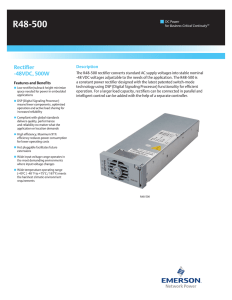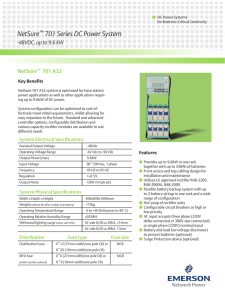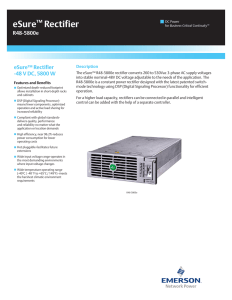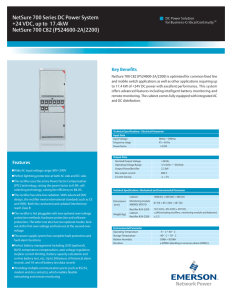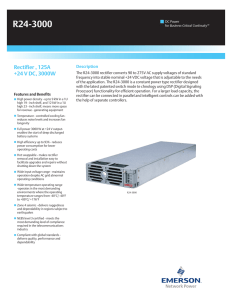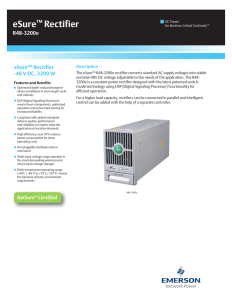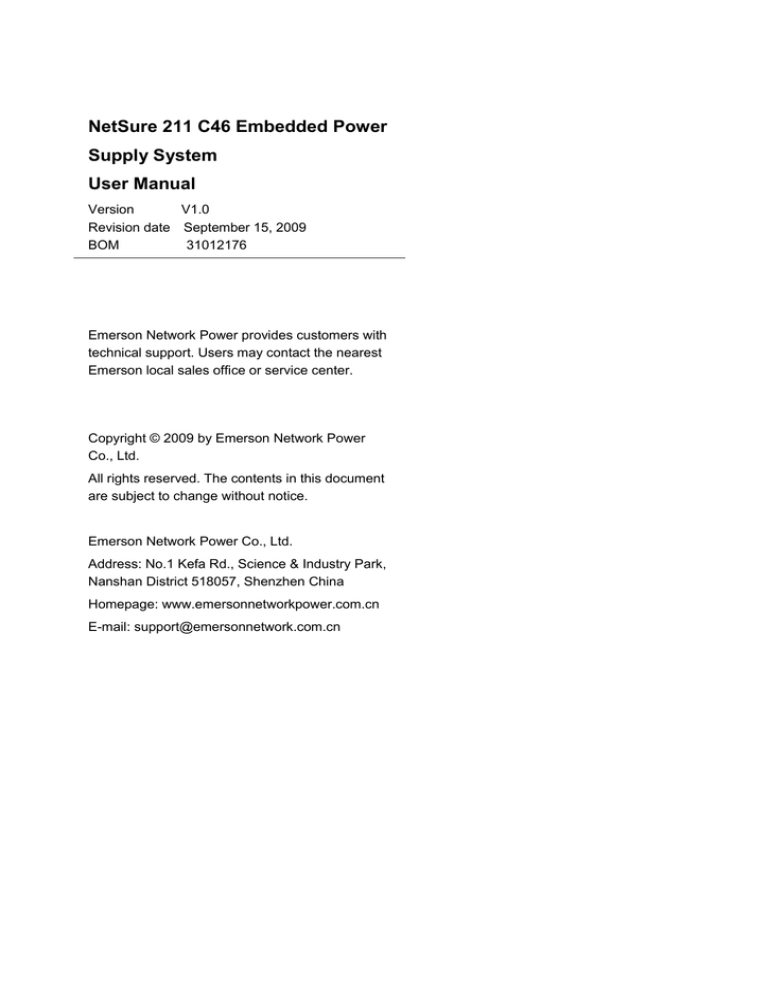
NetSure 211 C46 Embedded Power
Supply System
User Manual
Version
V1.0
Revision date September 15, 2009
BOM
31012176
Emerson Network Power provides customers with
technical support. Users may contact the nearest
Emerson local sales office or service center.
Copyright © 2009 by Emerson Network Power
Co., Ltd.
All rights reserved. The contents in this document
are subject to change without notice.
Emerson Network Power Co., Ltd.
Address: No.1 Kefa Rd., Science & Industry Park,
Nanshan District 518057, Shenzhen China
Homepage: www.emersonnetworkpower.com.cn
E-mail: support@emersonnetwork.com.cn
Safety Precautions
To reduce the chance of accident, please read the safety precautions very carefully before operation. The
"Caution, Note, Warning, Danger" in this book and on the product do not represent all the safety points to be
observed, and are only supplement to various safety points. Therefore, the installation and operation personnel
must receive strict training and master the correct operations and all the safety points before operation.
When operating Emerson products, the operation personnel must observe the safety rules in the industry, the
general safety points and special safety instructions specified in this book.
Electrical Safety
I. Hazardous voltage
Danger
Danger
Some components of the power supply system carry hazardous voltage in operation. Direct contact or indirect contact
through moist objects with these components will result in fatal injury.
Observe safety rules in the industry when installing the power supply system. The installation personnel must be
licensed to operate high voltage and AC power.
In operation, the installation personnel are not allowed to wear conductive objects, such as watches, bracelets,
bangles and rings.
When you spot the cabinet with water or moisture, turn off the power immediately. In moist environment,
precautions must be taken to keep moisture out of the power supply system.
"Prohibit" warning label must be attached to the switches and buttons that are not permitted to operate during
installation.
Danger
Danger
High voltage operation may cause fire and electric shock. The connection and wiring of AC cables must be in compliance
with the local rules and regulations. Only those who are licensed to operate high voltage and AC power can perform high
voltage operations.
II. Tools
Warning
In high voltage and AC operation, specialized tools must be used.
III. Thunderstorm
Danger
Danger
Never operate on high voltage, AC, iron tower or mast in the thunderstorm.
In thunderstorms, a strong electromagnetic field will be generated in the air. Therefore the equipment should be
well earthed in time to avoid damage by lightning strikes.
IV. ESD
Note
The static electricity generated by the human body will damage the static sensitive elements on PCBs, such as large-scale
ICs. Before touching any plug-in board, PCB or IC chip, ESD wrist strap must be worn to prevent body static from
damaging the sensitive components. The other end of the ESD wrist strap must be well earthed.
V. Short circuit
Danger
Danger
During operation, never short the positive and negative poles of the DC distribution unit of the power supply system or the
non-grounding pole and the earth. The power supply system is a constant-voltage DC power device, short circuit will result
in equipment burning and endanger human safety.
Check the polarity of the cable and connection terminal when performing DC live operations.
As the operation space in the DC distribution unit is very tight, please carefully select the operation space.
Never wear a watch, bracelet, bangle, ring, or other conductive objects during operation.
Use insulated tools.
In live operation, keep the arm, wrist and hand tense, so that when the tool in operation slips, the movement of
the human body and tool is reduced to a minimum.
BLVD
The power supply system has battery low voltage disconnection (BLVD) function. BLVD means when battery
voltage drops down to 43.2V, the power supply system cuts the load off to prevent over-discharge.
BLVD is enabled before delivery, which means that if power outage lasts for a long time or the power supply
system fails, there might be BLVD. Users should classify the loads and connect the priority loads to BLVD routes.
For vital loads, users can disable BLVD to ensure reliability of the power supply.
The method of disabling BLVD is:
Set ‘BLVD disabled’ parameter through the monitoring module main menu
BLVD.
Settings (password: 1)
LVD
Note
Noti
Warning
ce
The advantage of BLVD is protecting the batteries from over-discharge. The disadvantage of BLVD is that when the
battery voltage drops down to a certain value, all the loads (including non-priority loads and priority loads) will be cut off
due to battery disconnection.
The advantage of disabling BLVD is prolonging the power supply of priority loads. The disadvantage is that disabling
cannot prevent unwanted power failure due to misoperation or power supply system failure.
Others
I. Safety
Note
Noti
Warning
ce
When replacing power input fuses of monitoring module and power distribution units, use the same type fuses to meet the
safety requirement.
II. Sharp object
Warning
When moving equipment by hand, wear protective gloves to avoid injury by sharp object.
III. Power cable
Note
Noti
Warning
ce
Please verify the cable labels before connection.
IV. Signal cables
Note
Noti
Warning
ce
The signal cables should be routed at least 150mm away from power cables.
Contents
Chapter 1 Overview ............................................................................................................................................................ 1
1.1 Model Description ................................................................................................................................................. 1
1.2 Composition And Configuration ............................................................................................................................ 1
1.3 Features ................................................................................................................................................................ 2
Chapter 2 Installation Instruction ......................................................................................................................................... 3
2.1 Safety Regulations ................................................................................................................................................ 3
2.2 Preparation ........................................................................................................................................................... 3
2.3 Mechanical Installation .......................................................................................................................................... 4
2.4 Electrical Installation ............................................................................................................................................. 5
2.4.1 Connecting Power Cables ......................................................................................................................... 5
2.4.2 Connecting Signal Cables ......................................................................................................................... 6
Chapter 3 Installation Testing.............................................................................................................................................. 8
3.1 Installation Check And Startup .............................................................................................................................. 8
3.2 Basic Settings ....................................................................................................................................................... 9
3.3 Alarm Check And System Operation Status Check .............................................................................................. 9
3.4 Final Steps .......................................................................................................................................................... 10
Chapter 4 Alarm Handling ................................................................................................................................................. 11
4.1 Handling Alarms.................................................................................................................................................. 11
4.2 Handling Rectifier Fault ....................................................................................................................................... 12
Appendix 1 Technical Data ............................................................................................................................................... 15
Appendix 2 Wiring Diagram............................................................................................................................................... 17
Appendix 3 Glossary ......................................................................................................................................................... 18
Chapter 1
Overview
Chapter 1 Overview
This chapter introduces model description, composition and configuration, and features of NetSure 211 C46
embedded power supply system (abbreviated as ‘system’ hereinafter).
1.1 Model Description
The model description of the system is given in Figure 1-1.
NetSure 211 C
4 6
Version No.
The number of the rectifier in the typical power supply system: 4
Region: China
Type of the rectifier: R48-1000
Brand name of the system
Figure 1-1 Model description
1.2 Composition And Configuration
The appearance of the system is shown in Figure 1-2.
Rectifier
DI/DO/temperature probe
DC positive busbar
connection terminal
AC input MCB Monitoring module Load MCB
Battery MCB
Figure 1-2 Appearance of the system
The configuration of the system is listed in Table 1-1.
Table 1-1 Configuration of the system
Component
Configuration
Rectifier
Model: R48-1000
Standard configuration: 4 pieces
Monitoring module
Model: M522B, M523B or M221B
Standard configuration: 1 piece
AC power distribution
AC input mode:
L + N + PE/220V
DC power distribution
Seven load MCBs:
4 × 16A/1P, 2 × 32A/1P, 1 × 50A/1P
Battery routes
Two battery MCBs:
1 × 30A/1P,
Others
Two digital input ports, two dry contact output ports, two temperature sensor ports
NetSure 211 C46 Embedded Power Supply System
User Manual
1
2
Chapter 1
Overview
The monitoring module is available in three different models. Their configurations are listed in Table 1-2.
Table 1-2 Configuration of the monitoring module
Models
Configuration
M522B
2D + 2DO, LCD display, network port, RS232 port
M523B
2DI + 2DO, LCD display, RS232 port
M221B
2DI + 2DO, no LCD display, three indicators indicating operation status of the system, RS232 port
1.3 Features
The rectifier uses the active Power Factor Compensation (PFC) technology, raising the power factor to 0.99.
The system has wide AC input voltage range: 90Vac ~ 290Vac.
The rectifier uses soft switching technology, raising the efficiency to 91%.
The rectifier has ultra-low radiation. With advanced EMC design, the rectifier meets international standards such
as CE, NEBS and YD/T983. Both the conducted and radiated interference reach Class B.
The rectifier safety design complies with UL, CE and NEBS standards.
The rectifier is of high power density.
The rectifier is hot pluggable. It takes less than 1min to replace a rectifier.
The rectifier has two over-voltage protection methods: hardware protection and software protection. The latter
one also has two optional modes: lock-out at the first over-voltage and lock-out at the second over-voltage.
The monitoring module has perfect battery management. The management functions include battery low voltage
disconnection (BLVD), temperature compensation, auto voltage regulation, stepless current limiting, battery
capacity calculation, on-line battery test, and so on.
The monitoring module can save up to 200 pieces of historical alarm records, and 10 sets of battery test data
records.
The monitoring module is of network design. With an RS232 port, Ethernet, dry contacts and other
communication ports provided, flexible networking is enabled to achieve remote monitoring and unattendance.
The system has complete fault protection and fault alarm functions.
NetSure 211 C46 Embedded Power Supply System
User Manual
Chapter 2
Installation Instruction
3
Chapter 2 Installation Instruction
This chapter introduces installation and cable connection. Before installation, please read through safety regulations,
and then follow the instructions provided in this chapter to carry out the installation and cable connection.
2.1 Safety Regulations
Certain components in this system carry hazardous voltage and current. Always follow the instructions below:
1. Only the adequately trained personnel with satisfactory knowledge of the power system can carry out the
installation. The most recent revision of these safety rules and local safety rules in force shall be adhered to during
the installation.
2. All external circuits that are below -48V and connected to the power system must comply with the requirements of
SELV as defined in IEC 60950.
3. Make sure that the power (mains and battery) to the system is cut off before any operations can be carried out
within the system cabinet.
4. The power cabinets shall be kept locked and placed in a locked room. The key keeper should be the one
responsible for the system.
5. The wiring of the power distribution cables should be arranged carefully so that the cables are kept away from the
maintenance personnel.
2.2 Preparation
Unpacking inspection
The equipment should be unpacked and inspected after it arrives at the installation site. The inspection shall be done
by representatives of both the user and Emerson Network Power Co., Ltd.
To inspect the equipment, you should open the packing case, take out the packing list and check against the packing
list that the equipment is correct and complete. Make sure that the equipment is delivered intact.
Cables
The cable should be selected in accordance with relevant industry standards.
It is recommended to use the RVVZ cables as AC cables. The cable should reach at least +70°C temperature
durability. Select the AC cable Cross-Sectional Area (CSA) according to Table 2-1.
Table 2-1 AC cable CSA selection
Connector
AC cable CSA
AC connection block
4mm2 ~ 6mm2
The CSA of DC cable depends on the current flowing through the cable, the allowable voltage drop and load peak
current. The recommended load peak current is 1/2 to 2/3 of MCB or fuse capacity.
Select the battery cable CSA according to Table 2-2. Select the load cable CSA according to Table 2-3.
Table 2-2 Battery cable CSA selection
Battery fuse rated
Max. battery
Min. cable
Max. cable length (allowable
Max. cable
Max. cable length (volt
current
current
CSA
voltage drop: 0.5V)
CSA
drop: 0.5V, with max. CSA)
63A
63A
10mm2
4m
16mm2
7m
Note:
1. The specs are applicable at ambient temperature of 25°C.
2. The battery cable should reach at least +90°C heat durability. It is recommended to use double-insulated copper-core
flame-retardant cable as battery cable
NetSure 211 C46 Embedded Power Supply System
User Manual
4
Chapter 2
Installation Instruction
Table 2-3 Load cable CSA selection
Load route
Max. output
Min. cable
Max. cable length (volt
rated current
current
CSA
drop: 0.5V, with min. CSA)
16A
16A
4mm2
7m
32A
32A
6mm2
5m
50A
50A
10mm2
6m
Note:
The specs are applicable at ambient temperature of 25°C
Max. cable
CSA
6mm2
10mm2
16mm2
Max. cable length (volt drop:
0.5V, with max. CSA)
10m
9m
9m
The CSA of the system earth cable should be the same as that of the largest power distribution cable and not less
than 4mm2.
The RS232 cable is shown in Figure 2-1.
RJ45
DB9
X2
X1
A
A amplified view
Figure 2-1
RS232 cable
The definition of the RS232 cable connector is shown in Table 2-4. Users should make RS232 cable according to the
description in Table 2-4.
Table 2-4 Definition of the RS232 cable connector
DB9
RJ45
X1.2
X2.3
X1.3
X2.6
X1.4
X2.7
X1.5
X2.4 & X2.5
X1.6
X2.2
X1.7
X2.8
X1.8
X2.1
2.3 Mechanical Installation
1. Install brackets.
Fix the brackets on the power supply subrack with bolts. Users can choose proper installation position according to
actual instance.
NetSure 211 C46 Embedded Power Supply System
User Manual
Chapter 2
Installation Instruction
5
2. Install the power supply subrack.
57.1
132.0
Fix the subrack in the cabinet with fixing screws. The installation dimensions are shown in Figure 2-2.
289.8
465
482.6
Figure 2-2 Installation dimensions (unit: mm)
2.4 Electrical Installation
2.4.1 Connecting Power Cables
Danger
Danger
1. Switch off all MCBs and fuses before the electrical connection.
2. Only the qualified personnel shall do the power cable connection.
3. The batteries may have dangerous current. Before connecting battery cables, make sure that the battery fuses at the system side
and the battery MCBs at the battery side are switched off. If there are no battery MCBs at the battery side, you should disconnect
any one of the connectors between battery cells to avoid live state of the system after installation.
4. Be careful not to reversely connect the battery. Otherwise, both the battery and the system will be damaged!
NetSure 211 C46 Embedded Power Supply System
User Manual
6
Chapter 2
Installation Instruction
The positions of connection terminals are shown in Figure 2-3.
DI/DO/temperature probe
DC positive busbar
connection terminal
Load MCB
Battery MCB
AC input MCB
Figure 2-3
Connection terminals
Refer to Table 2-5 to connect the input and output cables.
Table 2-5 Connection descriptions of input and output cables
Connection
Cable
From
To
AC input cable
AC power
AC input terminals
DC output cable
DC output terminals
Load MCBs
Battery cable
Battery string
Battery MCBs
After the cable connections, reinstall the plastic cover of the AC input terminals.
2.4.2 Connecting Signal Cables
The position of the DI/DO/temperature probe connection terminal is shown in Figure 2-3, and the screen print is
shown in Figure 2-4.
+
DI1
+
DI2
Figure 2-4
NO COM NO COM PS Ground T1
DO1
DO2
Temp. sensor
DI/DO/temperature probe connection terminal
NetSure 211 C46 Embedded Power Supply System
User Manual
T2
Chapter 2
Installation Instruction
Connection method:
Peel one end of the signal cable and insert it into the DI/DO/temperature probe connection terminal. Fasten the
connection by tightening the screw on the terminal.
Note
Noti
Warning
ce
The output dry contacts are normally open by default. If users want to use normally-closed contacts, they need to pull out the
monitoring module and change the NO-COM connections to NC-COM connections at the dry contact socket. The position and
definition of the dry contact socket is shown in the following figure.
The default associations of the relays are: critical alarm associating with DO1, and major alarm associating with DO2.
A
A amplified view
NetSure 211 C46 Embedded Power Supply System
User Manual
7
8
Chapter 3
Installation Testing
Chapter 3 Installation Testing
This chapter introduces procedures of installation testing. The corresponding safety rules shall be adhered to in the
test.
3.1 Installation Check And Startup
Before the test, inform the chief manufacturer representative. Only the trained electrical engineer shall conduct the
system testing. Remove metal objects that may cause shortcircuit, such as rings, watches, and so on.
During operation, watch out for hazardous voltage, and avoid personnel injury and property damage. Before the test,
ground the equipment properly. Installation check must be done before testing, then the batteries can be charged for
the first time.
Make sure that the AC input MCB and load MCBs are switched off. Make sure that all the devices are properly
installed.
Check the system according to the following items listed below.
Installation check
Check item
Verify all the MCBs, fuses and cables
Verify the system grounding, input and output cable connection
Verify the battery cell number, connection, and battery string polarities
Make sure all the cable connections are firm and reliable
Make sure all the communication cables and alarm cables are connected to the monitoring module. Check
That the temperature sensor, if any, has been installed correctly
OK
Comments
Startup preparations
Check item
Make sure that all the MCB are switched off and all the fuses are removed
Measure the AC input voltage. Make sure the input voltage is within the allowable range
Check that the battery string circuit is not closed
Connect the disconnected batteries to the battery string circuit
Measure with a voltmeter across the connection points of each battery and make sure that the polarity is
right. For a lead-acid battery with 24 cells, the voltmeter should read 2.0V/cell ~ 2.1V/cell or 48V/battery ~
51V/battery. If the voltage of certain cell is lower than 2.0V, that cell must be replaced
Check with an ohmmeter that there is no short circuit between the positive & negative distribution busbars,
or between the positive & negative battery poles
(Note: Pull out all modules before the check and restore them after the check)
OK
Comments
Umin=___V
Umin=___V
Startup
Check item
Switch on the system AC input MCB, and the monitoring module should display the correct voltage and
current values
The green indicator on the rectifier should turn will be on and the fan should will start running. After a
certain delay, the monitoring module should show that the power supply voltage is 53.5V
Check the system voltage and busbar polarity with a voltmeter. The voltage difference between the
measured value and displayed value should be less than ± 0.3V
Start and stop each rectifier by inserting and unplugging the rectifiers. Check their output voltages
NetSure 211 C46 Embedded Power Supply System
User Manual
OK
Comments
Chapter 3
Installation Testing
9
3.2 Basic Settings
When the system is put into service for the first time, the parameters of the monitoring module must be set based on
the actual system configuration, battery number and capacity, user’s charge current limiting and other functional
requirements. Only after that can the monitoring module display system operation information and control the output.
To change the settings, enter the main menu
Settings (password: 1)
Battery Settings
Batt. Selection
submenu, set the ‘Mode’ parameter to ‘Manual’, and then return to the submenus of Battery Settings menu to set the
parameters For detailed setting method, see SCU + Series Monitoring Module User Manual.
Check item
The system model has been set correctly in factory before delivery, check that the setting agrees with
the actual system (48V/SET)
The battery string number set at the monitoring module should be the same as the number actually
connected (Default: 2)
Set the battery capacity according to the total capacity of all the battery connected to the system.
Default: 300Ah
Configure the temperature compensation coefficient according to the battery manufacturer’s
requirement. Setting range: 0mV/°C ~ 500mV/°C. Default: 72mV/°C (if no temperature sensor is
installed, do not set this parameter)
Set the charge current limit according to your needs. Setting range: 0.1C10 ~ 0.25C10 (Default: 0.1C10)
Set the monitoring module according to the voltage suggested by the battery supplier.
Float Charge (FC) voltage range: 42V ~ Boost Charge (BC) voltage. Default: 53.5V.
BC voltage range: FC voltage ~ 58V. Default: 56.4V
For batteries that do not need BC, set the BC voltage to FC voltage plus 0.1V
Measure the battery voltage with a multimeter and record it. Enter main menu
OK
Comments
Maintenance
(password: 1)
RectTrim submenu. Set the output voltage of the rectifier to the value of the battery
voltage. Insert the battery fuse. Set the output voltage of the rectifier to 53.5V
Enter the Batt. Selection submenu. Set the ‘Mode’ parameter to ‘Auto’
Note*: if the capacity of the battery is smaller than 50Ah, set the ‘Capacity’ to 50Ah
3.3 Alarm Check And System Operation Status Check
Alarm check
Check that all functional units can trigger alarms and the alarms can be displayed on the monitoring module.
Check item
Pull out one rectifier, and the ‘Rect N Com Failure’ alarm should be triggered. Insert the rectifier in, and
the alarm should disappear. Repeat the same procedures on other rectifiers
Switch off battery MCB 1, and the ‘Batt1 Failure’ alarm should be triggered. Switch on battery MCB 1,
and the alarm should be cleared. Repeat the same on battery MCB 2
Switch off a load MCB connected to load, and the alarm ‘Load Fuse N Failure’ should be triggered.
Switch on the load MCB, and the alarm should be cleared. Repeat the same on other load MCBs
Switch off all the battery MCBs. Keep only one rectifier in operation. Through the monitoring module,
adjust the rectifier FC voltage to make it lower than the alarm point. The alarm ‘DC Voltage Low’ should
be triggered
Keep the rectifiers in operation. Set through the monitoring module the battery management parameter
to ‘Manual’. Enter the maintenance menu at the monitoring module. Select ‘Disconnect’ and confirm it.
The battery protection contactor should be open, and the ‘BLVD’ alarm should be displayed at the
monitoring module
OK
Note: The monitoring module will give alarms approximately 10s after the alarms are triggered. Enter main menu
view the alarm information
NetSure 211 C46 Embedded Power Supply System
User Manual
Comments
Operation to
10
Chapter 3
Installation Testing
System operation status check
There should be no alarms during normal system operation. The system operation status check can be conducted
through the monitoring module.
Check item
The system model is correct (48V/SET)
The monitoring module should display the correct AC voltage
The difference between the voltage displayed by the monitoring module and the actual value should
be less than ±0.3V
The difference between the battery current displayed by the monitoring module and the actual value
should be less than 1%
Check the number of the rectifier through the monitoring module. The number should be consistent
with the actual number
Check the voltage, current, current limiting point of rectifiers through the monitoring module. They
should agree with the actual parameters
For the system configured with temperature sensor, the monitoring module should display the battery
ambient temperature. Hold the probe of the temperature sensor and watch the monitoring module,
which should display the change of temperature
OK
Comments
3.4 Final Steps
Check item
Make sure that materials irrelevant to the equipment have been all removed
Fill in the installation report and hand it over to the user
Fill in the parameter table on the cabinet door
OK
Comments
If any defect is found in this equipment, inform the personnel responsible for the contract.
If repairing is needed, please fill in the FAILURE REPORT and send the report together with the defective unit to the
repairing center for fault analysis.
NetSure 211 C46 Embedded Power Supply System
User Manual
Chapter 4
Alarm Handling
11
Chapter 4 Alarm Handling
This chapter describes the handling of alarms, as well as the preventive maintenance of the system during system
daily operation.
The maintenance personnel must have adequate knowledge about the system.
Note
1. The maintenance must be conducted under the guidance of related safety regulations.
2. Only the trained personnel with adequate knowledge about the system can maintain the inner part of the system.
4.1 Handling Alarms
The monitoring module alarms are classified in four types: critical alarm, major alarm, observation alarm, and no
alarm.
Critical alarm, major alarm: These two types of alarms have strong impacts on the system performance. Whenever
these alarms are generated, users are supposed to handle them immediately. The monitoring module will turn on the
alarm indicator and generate audible alarm.
Observation: When this type of alarm is raised, the system maintains normal output for a while. If the alarm occurs
during watch time, it should be handled immediately. If the alarm occurs during non-watch-time, handle it at the
beginning of the watch time. The monitoring module will only turn on the alarm indicator.
No alarm: In case of an alarm set as ‘no alarm’ by the users, no visual or audible alarm will be generated and the
system will work normally.
The handling methods of common alarms are given in Table 4-1.
Table 4-1 Troubleshooting
No.
Alarm
1
Mains Failure
2
AC Voltage High
3
AC Voltage Low
4
DC Volt High
5
DC Volt Low
6
Load Fuse Alarm/
Batt Fuse Alarm
Handling method
If the failure does not last long, the battery will power the load. If the cause is unknown or the failure
lasts too long, a diesel generator should be started. Before using the generator’s power, it is
suggested to run the generator five minutes to stabilize the power output
Check if the AC Over-voltage point is too low. If yes, reset the value.
A mild over-voltage does not affect the system operation. However, the rectifier will stop operation
when the mains voltage is more than 305V. Therefore, if the power supply voltage is often high,
consult with the power grid maintenance personnel to improve it.
Check if the AC Under- voltage point is too high. If yes, reset the value.
When the mains voltage is lower than 176V, the output power of the rectifiers will be derated. If the
power supply voltage is often low, consult with the power grid maintenance personnel to improve it.
1. Check the system DC output voltage and value of ‘Over’ set through the monitoring module. If the
set value is improper, correct it.
2. Find out the rectifier that has caused the alarm.
First of all, ensure that the batteries can operate normally. Then switch off the AC input of all
rectifiers. Power on the rectifiers one by one. If the over-voltage protection is triggered when a
certain rectifier is powered on, that rectifier is the faulty one, replace it
1. Check the system DC output voltage and value of ‘Under’ set through the monitoring module. If
the set value is improper, correct it.
2. Check if the alarm is caused by mains failure. If yes, disconnect certain loads to prolong the
operation of the whole system.
3. Check if the alarm is due to rectifier fault, find out the faulty rectifier and replace it.
4. Compare the total load current with the total rectifier current during float charge. If the former is
bigger than the latter, disconnect partial loads, or add several rectifiers, with at least one rectifier
redundant, to make the total rectifier current bigger than 120% of the total load current
Check if the MCB or fuse of the route is switched off. If the MCB is open, find out the fault and
remove it. Or check the voltage at the alarm fuse. If the voltage is almost 0V, the fuse is normal.
Otherwise, the alarm loop is faulty. Please contact Emerson
NetSure 211 C46 Embedded Power Supply System
User Manual
12
Chapter 4
No.
Alarm Handling
Alarm
7
LVD2
8
Rect Failure
9
Rect Protect
10
Rect Fan Fails
11
Rect Not Respond
12
Batt Over Temp
Handling method
1. Check if there is a mains failure, and the battery voltage is lower than the ‘BLVD’ value, or the
battery discharge time is more than the ‘BLVD Time’.
2. Check if someone manually disconnected the battery from the system
The red indicator on the rectifier will turn on.
1. Reset the rectifier by powering it off and then on again.
2. If the alarm persists, replace the rectifier
Check if the mains voltage is outside the range of 80V (AC under-voltage point) ~ 295V (AC
over-voltage point).
If the power supply is often outside this range, consult with the power grid maintenance personnel to
improve it
1. Check whether the rectifier fan is still working.
2. If the fan stands still, check whether the fan is blocked or not. If yes, clean it; if not, or if the fault
persists after the fan is cleaned, replace it (see 4.2 Handling Rectifier Fault)
Check if the communication between rectifier and monitoring module failed. If the communication is
normal, restart the rectifier by pulling it out and pushing back in. If the alarm persists, replace the
rectifier
1. Check if there is a battery internal fault. If yes, replace the battery.
2. Check if the battery room temperature is too high. If yes, cool down the battery room
4.2 Handling Rectifier Fault
Handling indicator fault
The symptoms of usual rectifier faults include: green indicator (run indicator) off, yellow indicator (protection indicator)
on, yellow indicator blink, red indicator (fault indicator) on and red indicator blink.
The indicators are shown in Figure 4-1 and handling methods of the rectifier faults are given in Table 4-2.
Run indicator
Protection indicator
Fault indicator
R48-1000
Figure 4-1
Rectifier indicator
Table 4-2 Handling methods of the rectifier faults
Symptom
Monitoring
module alarms
Causes
No input/output voltage
Run indicator off No alarm
Run indicator
blinks
Yellow
indicator on
No alarm
Rect over temp
Assistant power source of the rectifier fails
The monitoring module performs operations
upon the rectifier
AC input voltage abnormal
Fan blocked
OverVentilation path blocked at
temperature the inlet or vent
protection
Ambient temperature too high
due to:
or the inlet too close to a heat
source
NetSure 211 C46 Embedded Power Supply System
Handling methods
Make sure there is input/output voltage
Change the position of the faulty module with
normal module. If the faulty module cannot
work normally, replace it
Make sure the AC input voltage is normal
Remove the object that blocks the fan
Remove the object at the inlet or vent
Decrease the ambient temperature or remove
the heat source
User Manual
Chapter 4
Symptom
Monitoring
module alarms
Causes
Check whether the rectifier communication is
normal. If not, check whether the
communication cable is in normal connection.
If the communication is normal while the
protection indicator is on, replace the rectifier
Change the position of the faulty module with
normal module. If the faulty module cannot
work normally, replace it
Ensure AC input voltage normally
Check whether the communication cable is in
normal connection
Reset the rectifier. If the protection is triggered
again, replace the rectifier
Rect protect
Power factor compensation internal
under-voltage or over-voltage
AC input over-voltage
Yellow
indicator blinks
Rect Not
Respond
Rectifier communication interrupted
Rect HVSD
Rectifier over-voltage
Two or more rectifiers have the same ID
number
Contact Emerson for maintenance
Serious current sharing imbalance (current
imbalance > ± 3%)
Check whether the rectifier communication is
normal. If not, check whether the
communication cable is in normal connection.
If the communication is normal while the
protection indicator is on, replace the rectifier
Fan fault
Replace the fan
Red indictor on
Rect Failure
Red indicator
blinks
Rect Fan Fails
13
Handling methods
Current sharing imbalance
Yellow
indicator on
Alarm Handling
Replacing rectifier fan
If the rectifier fan is faulty, it should be replaced. Refer to Figure 4-2, for the replacing procedures:
1. Use a Phillips screwdriver to remove the two fixing screws and pull out the front panel.
2. Unplug the power cable of the fan and remove the fan.
3. Plug in the new fan.
4. Install the new fan, with fan blowing-direction inward.
5. Replace the front panel.
Fixing hole
Fan Fixing hole
Front panel
Figure 4-2
Disassembling the front panel
Replacing rectifier
1. Take a new rectifier and check it for any damage.
2. Loosen the fixing screw of the handle of the rectifier with a Phillips screwdriver.
3. Press the rectifier handle to pop it out. Pull out the faulty rectifier from the rack by grabbing its handle.
Be careful with the rectifier just pulled out from the system, as it could be very hot due to long-term operation. Do not
let it slip away and get damaged.
4. Hold the rectifier handle, push the new rectifier into the slot and make sure the connection is good.
NetSure 211 C46 Embedded Power Supply System
User Manual
14
Chapter 4
Alarm Handling
After a brief delay, the rectifier RUN indicator will turn on and the fan will start running.
5. Check that the new rectifier works normally.
You should make sure that:
1) The monitoring module recognizes the new rectifier.
2) The new rectifier shares current with other rectifiers.
3) When this new rectifier is pulled out, there is a corresponding alarm and the monitoring module displays the alarm.
If the new rectifier passes all the above tests, the replacement is a success.
6. Push the handle back into the front panel to lock the rectifier.
7. Fix the fixing screw of the handle of the rectifier with a Phillips screwdriver.
NetSure 211 C46 Embedded Power Supply System
User Manual
Appendix 1
Technical Data
15
Appendix 1 Technical Data
Table 1 Technical data
Parameter
category
Environmental
AC input
DC output
AC input
alarm and
protection
DC output
alarm and
protection
Parameter
Operating temperature
Storage temperature
Relative humidity
Altitude
Pollution level
Others
Input phase voltage
Input voltage range
Input frequency
Max input current
Power factor
Over-voltage level
Rated output voltage
Output voltage range
Output current
Total regulation
Efficiency
Noise (peak-peak)
Weighted noise
AC input over-voltage
alarm point
AC input over-voltage
alarm recovery point
AC input under-voltage
alarm point
AC input under-voltage
alarm recovery point
AC input over-voltage
protection point
AC input over-voltage
protection recovery point
AC input under-voltage
protection point
AC input under-voltage
protection recovery point
DC output over-voltage
alarm point
DC output over-voltage
alarm recovery point
DC output under-voltage
alarm point
DC output under-voltage
alarm recovery point
BLVD point
Current sharing
Rectifier
Derate by input (45°C)
Description
-5°C ~ 40°C
-40°C ~ 70°C
≤ 90%RH
≤ 2000m (derating is necessary above 2000m)
Level 2
No conductive dust or erosive gases. No danger of explosion
220Vac
90Vac ~ 290Vac
45Hz ~ 65Hz
Single phase, input current of each rectifier ≤ 7A
≥ 0.99
Level 2
-53.5Vdc
-42.3Vdc ~ -57.6Vdc
80A
≤ ±1%
≥ 90%
≤ 200mV
≤ 2mV
Default: 280Vac ± 10Vac, cofigurable through monitoring module
15Vac lower than the AC input over-voltage alarm point
Default: 180Vac ± 10Vac, configurable through monitoring module
15Vac higher than the AC input under-voltage alarm point
Default: 305Vac ± 5Vac
10Vac lower than the AC input over-voltage protection point
Default: 80Vac ± 5Vac
15Vac higher than the AC input under-voltage protection point
Default: 57.6Vdc ± 0.2Vdc, configurable through monitoring module
0.5Vdc lower than the over-voltage alarm point
Default: 45.0Vdc ± 0.2Vdc, configurable through monitoring module
0.5Vdc higher than the under-voltage alarm point
Default: 43.2Vdc ± 0.2Vdc, configurable through monitoring module
The imbalance is better than ± 5% rated output current. Test current range: 10% ~
100% rated current.
The imbalance is better than ± 3% rated output current. Test current range: 50% ~
100% rated current
Input voltage: 176Vac ~ 290Vac, rectifier max. output power: 50% rated power,
1000W
Input voltage: 90Vac ~ 176Vac, rectifier output power: linear derating power
NetSure 211 C46 Embedded Power Supply System
User Manual
16
Appendix 1
Technical Data
Parameter
category
Parameter
Output delay
Fan speed
Rectifier
Over-voltage protection
Temperature derating
CE
RE
Immunity to EFT
Immunity to ESD
Immunity to Surges
Acoustic noise
Insulation resistance
EMC
Insulation strength
ROHS
Mechanical
Size (W ×D
×H) (mm)
Weight (kg)
System
Rectifier
System
Rectifier
Description
Output voltage can rise slowly upon rectifier start up. The rise time is configurable
Rectifier fan speed can be adjusted automatically
The rectifier provides over-voltage hardware and software protection. The
hardware protection point is between 59V and 60V, and manual resetting is
required to restore operation. The software protection point is between 56V and
59V (required to be 0.5Vdc higher than the output voltage, default: 59Vdc), and
can be set through the monitoring module.
There are two software protection modes, which can be selected through the
software at the host:
1. Lock out at the first over-voltage
Once the output voltage reaches protection point, the rectifier will shut down and
hold that state. Manual resetting is required to restore the operation.
2. Lock out at the second over-voltage
When the output voltage reaches the software protection point, the rectifier will
shutdown, and restart automatically after 5s. If the over-voltage happens again
within a set time (default: 5min. Configurable through monitoring module), the
rectifier will shut down and hold that state. Manual resetting is required to restore
the operation.
Manual resetting: Resetting can be done manually through the monitoring module,
or by removing the rectifier from system
-20°C ~ 45°C, 1000W.
45°C ~ 75°C, linear derating.
> 75°C, 0W
Class A
EN55022
Level 4
EN61000-4-4
Level 3
EN61000-4-2
Level 4
EN61000-4-5
≤ 55dB (A) (When the ambient temperature is 25°C)
At temperature of 20°C ~ 30°C and relative humidity not bigger than 90%RH,
apply a test voltage of 500Vdc. The insulation resistances between AC circuit and
earth, DC circuit and earth, and AC and DC circuits are all not less than 2MΩ
(Rectifiers and monitoring module from the system before the test.)
AC to DC circuits: 50Hz, 3000Vac (RMS).
AC circuit to earth: 50Hz, 2500Vac (RMS).
DC circuit to earth: 50Hz, 1000Vac (RMS).
Assistant circuit (not directly connected to the host circuit): 50Hz, 500Vac (RMS).
For all the three tests above, there should be no breakdown or flashover within
1min, with leakage current not bigger than 10mA
Compliant with R5 standard
437 × 289 × 132
86.5 × 241.1 × 40.8
≤ 13
≤ 1.5
NetSure 211 C46 Embedded Power Supply System
User Manual
Appendix 2 Wiring Diagram
Appendix 2 Wiring Diagram
1
Busbar-
2
5
Busbar+
1
8-J218
4-46
4-31
2
Shunt
8-J217
4-22
4-20
W03
1
2
4-35
4-47
3
BLVD
2
1
5-6
3
7
4
8
5
9
10
8-PE
W05
W05
4-39
4-41
4 1
5 2
6 3
4-36
2
6
W02
4-32
4-44
X1
W05
1
4-49
3-4
W05
13
DC+
6
1
2
7
AC Input
BAT CB2
1
2
BAT CB1
1
2
LOAD CB7
1
2
LOAD CB6
2
1
LOAD CB5
1
2
LOAD CB4
2
1
LOAD CB3
1
2
J1
LOAD CB2
1
2
4-29
LOAD CB1
DA411X3
Alarm board
1
3
J2
6-J2-2
6-J2-1
LOAD1-
6-J2-3
LOAD2-
6-J2-5
6-J2-4
LOAD3-
LOAD4-
LOAD5-
LOAD6-
4-28
4-30
6-J2-7
6-J2-6
LOAD7-
BAT1-
2
BAT2-
4
L
N
W02
8-N
10-N
W02
8-L1
10-L1
4
12-9
12-12
6-J1-1
12-11
1-2
3-X1-1
5-6
3-X1-2
5-6
5-6
SCU+
connector
W01
10-J207-2
10-J207-1
2-2
2-1
3-1
BAT CB2-2
BAT CB1-2
3-X1-6
3-1
1-2
10-H52
49 47 45 43 41 39 37 35 33 31 29 27 25 23 21 19 17 15 13 11 9 7 5 3 1
50 48 46 44 42 40 38 36 34 32 30 28 26 24 22 20 18 16 14 12 10 8 6 4 2
4-50
12-11
10
H52
4-4
SA411X3
J208
(L1) (L2)
4-2
J207
L1 N
J212
DC-
8-J217
W03
7-2
W02
7-4
W02
J211
DC+
8-J218
W03
13
W07
9
W06
W03
8-J215
1-1
10-J212
8
J215
J217
DC-
J216
SA411X2
(L1) (L2)
5-1
10-J211
5-7
W02
12-4
W01 12-3
12-2
12-1
L1 N
PE
J218
DC+
7-2 7-4
W02 W02
11
12
IB0
connector
Dry contactor
12-8
W01 12-7
12-6
12-5
12
2
11
+
-
DI1
+
-
DI2
NO
COM NC
DO1
NO
COM
1
NC
NO.
1
2
3
4
5
6
7
8
9
10
11
12
DO2
Figure 1 Wiring diagram of the system
NetSure 211 C46 Embedded Power Supply System
User Manual
Connect from
12-1
12-2
12-3
12-4
12-5
12-6
12-7
12-8
12-9
12-10
12-11
12-12
Connect to
11-D11+
11-D1111-D12+
11-D1211-DO1 NO
11-DO1 COM
11-DO2 NO
11-DO2 COM
4-19
10-H52
4-25
4-23
17
18
Appendix 3
Glossary
Appendix 3 Glossary
Abbreviation
Amb.Temp
Batt
BC
BLVD
Cap
CommMode
CurrLimit
CycBC
Con Alarm Voice
Hist Alarm
HVSD
InitParam
InitPWD
LLVD
LVD
MCB
Ph-A
PWD
Rect
Shunt coeff
SPD
SW Version
Sys
Temp
Temp Comp
Volt
Full word
Ambient Temperature
Battery
Boost Charging
Battery Lower Voltage Disconnection
Capacity
Communication Mode
Current Limit
Cyclic Boost Charging
Control Alarm Voice
Historical alarm
High Voltage Shutdown
Initialize Parameters
Initialize Password
Load Low Voltage Disconnection
Low Voltage Disconnection
Miniature Circuit Breaker
Phase A
Password
Rectifier
Shunt Coefficient
Surge Protection Device
Software Version
System
Temperature
Temperature Compensation
Voltage
NetSure 211 C46 Embedded Power Supply System
User Manual



